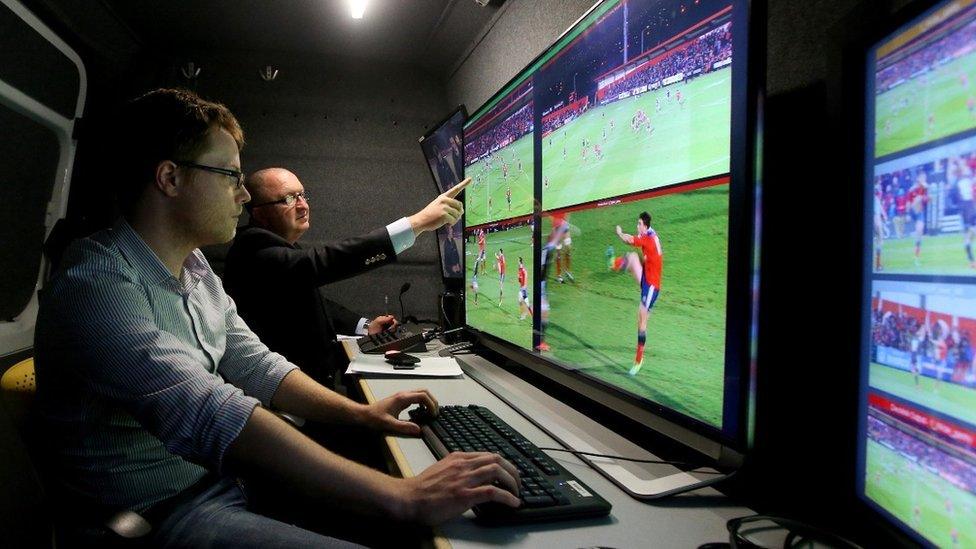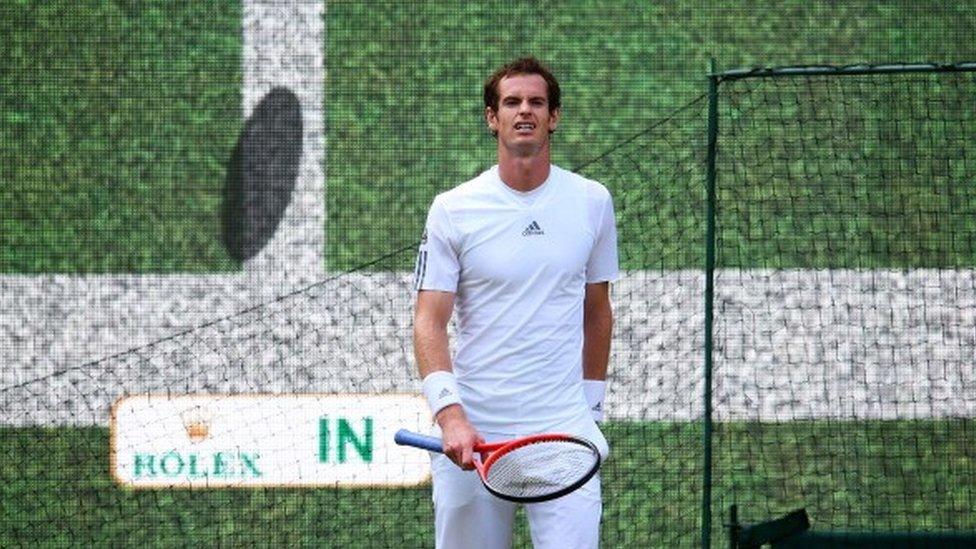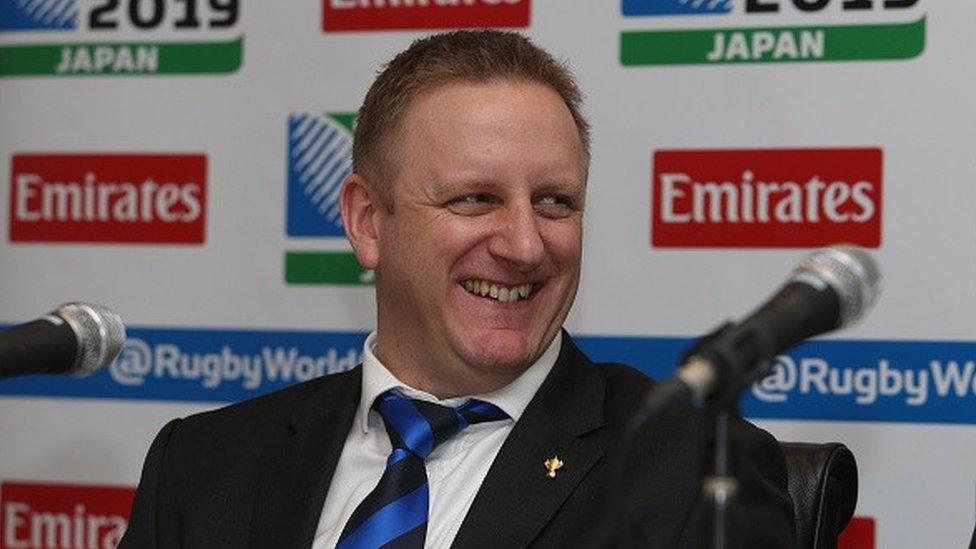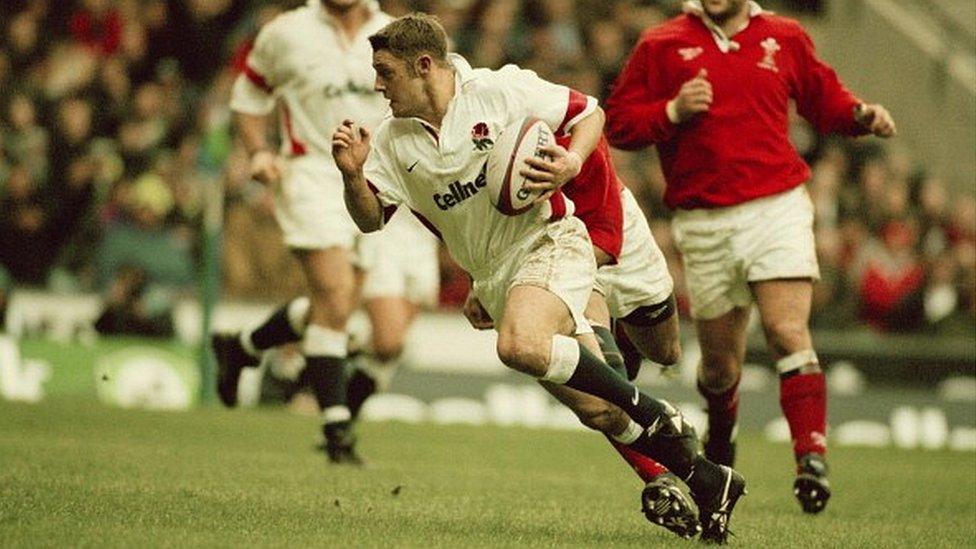Rugby World Cup: Hawk-Eye technology ready for big decisions
- Published
Hawk-Eye technology is to be used at the Rugby World Cup to assist refs and medics
The difference between success and failure at top level rugby union can come down to a matter of inches or centimetres.
Which is why the organisers of the Rugby World Cup 2015 - which starts on Friday - are using the latest technology to make sure match officials can not only make the correct decisions, but can also do so speedily for the benefit of players and fans.
Rugby authorities believe the use of the Hawk-Eye system will ensure that rather than controversy, rugby followers and the 20 participating teams will instead be discussing only the action and excitement over the next six weeks of the tournament.
And, not only will the video system improve decision-making by the television match official (TMO) but it will also assist with player safety.
"There are multiple benefits from our point of view in using Hawk-Eye," Alan Gilpin, head of Rugby World Cup at international governing body World Rugby, tells the BBC.
"We started looking at technology about 18 months ago - at that point focusing on match officiating, and asking how could we enhance the match officials' decision making with technology."
'Really significant'
He says that as they went through testing with Hawk-Eye, in Pro 12 Rugby (formerly the Celtic League), at the Under-20 World Championship, and in selected international matches, a lot of other benefits emerged, including player welfare.
"We quite quickly realised that actually this video replay technology - from an identification and management of concussion in particular - could be really significant.

The split-screens allow the TMO to see incidents instantly and from many angles
"We are using it very significantly in the head injury assessment process, in the identification and management of concussion."
The system - delivered by Hawk-Eye "Smart Replay" technology - allows the TMO official monitoring the footage in a special video van, to have access to simultaneous and synchronised multiple-angle replays, in real-time and in slow motion.
It also allows the official to zoom digitally in on any camera shots they want to see in more detail.

Hawk-Eye had a final pre-World Cup test run at the England v Ireland match earlier in September
Previously the TMO had to ask the TV producer of the host broadcaster to painstakingly rewind back through various camera shots.
World Rugby says that seeing an incident simultaneously from all broadcast angles makes for thorough and effective decision making. The Hawk-Eye content is made available immediately to match officials, coaches, as well as team and stadium medical staff.
Injured players can be shown footage to explain to them why they are not being allowed to return to the field of play.
'Cost-effective'
"We are also using it in our disciplinary processes, with our citing commissioners, and ultimately throughout the Rugby World Cup we will be using it to provide teams with additional footage for team analysis, and for analysis of their opponents, so it is a really significant series of benefits for us," adds Mr Gilpin.
And Mr Gilpin says that given the fact that the World Cup is the sporting and financial showcase event for rugby union, then the cost involved, which World Rugby has not disclosed, is value for money.

Hawk-Eye systems are used in a number of other sports, including tennis
"Working with the host broadcaster, working with technology like Hawk-Eye, can actually be quite cost-effective, it is not prohibitively expensive," he says. "And I think we will review that after the World Cup and look at how to find how the systems can be used in other tournaments.
"We will be looking at where it was effective, where things could have been improved, and then looking at how that technology be used - not just in a six week event."
Olympic role
Hawk-Eye is already a well-known name to the sporting public through its tennis line calling technology, and for helping cricket officials adjudicate on lbws as part of that sport's decision review system (DRS). The company has also developed goal-line technology for football.
The Basingstoke, UK, firm was acquired by Japanese electronics giant Sony in a multi-million pound deal in 2011.
"What we are doing now [in the Rugby World Cup] with video distribution, we have been doing for quite some time. We covered more than 20 sports at the Olympic Games in 2012," says Steve Carter, managing director of Hawk-Eye Innovations.
"Previously the TMO had to wait for the TV director to show him footage of various incidents, whereas now he is sitting directly next to our operator so we can give him footage live during the match."

Mr Gilpin says Hawkeye will enhance high-quality decision making
He says different camera angles can be viewed simultaneously to show, for example, whether a player's foot went out of touch before the ball was grounded for a try.
"You need to capture all of the broadcast vision to make sure that it is synchronised in time," he says.
"And you need a very slick front end, and skilled operators to make sure the TMO gets the vision he needs to make a decision as quickly as possible, and that we minimise any interruptions to the flow of the game. "
He says Hawk-Eye won the World Rugby contract after showing them their work at the 2012 Olympics, and with AFL football in Australia, NHL ice hockey in the US, and also Major League baseball.
'Brave face'
Former England winger David Rees won 11 caps between 1997 and 1999, and says Hawk-Eye could help protect players from themselves. He scored a famous try against New Zealand when he took a hard blow to the head which knocked out his front teeth.
"Sometimes the adrenalin is pumping, you are desperate to play, you don't want to let the team down, so you carry on - you put on a brave face," he says.

Ex-England winger David Rees says Hawkeye will stop players continuing to play when injured
He played on, but says with the new technology he would probably not be allowed to continue, and "that is good for the safety and welfare of players".
Ian Ritchie, chief executive of English rugby union governing body the RFU, knows better than most the power of technology, having used Hawk-Eye at Wimbledon when he was boss of the All England Lawn Tennis Club.
"I think it was a great success," he says. "It engaged all the people who were watching, to see whether the ball was in or out, created a great deal of interest, and of course accuracy in terms of then determining whether it was or it wasn't [in].
"Let's embrace technology, not forgetting that it is an add-on, it is an assistance, it should never overwhelm the game, or overwhelm the sport, but use it when it is judicious and can be helpful, and I think that is what is going to happen during this World Cup."